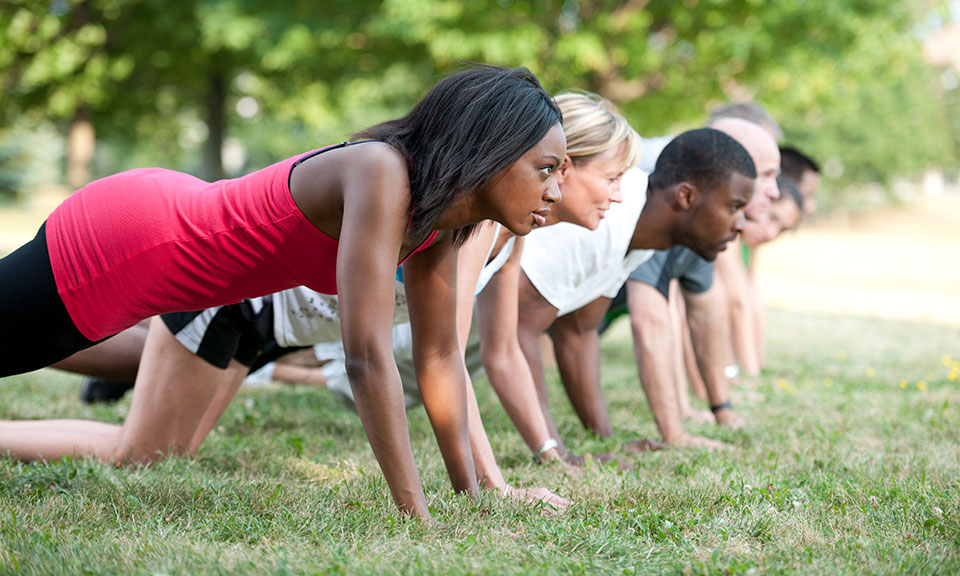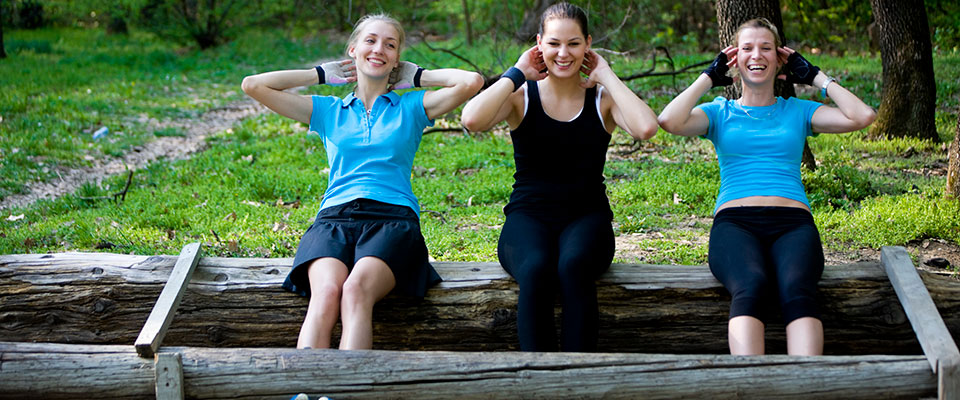RUN BETTER WITH OUR NEWSLETTER
Weekly updates on gear, offers & events
JOIN NOW
Circuit training is the effective combination of cardio vascular fitness and resistance training. Exercises are short and intense with timed intervals between each station. Many of the exercises involve using your own body weight, medicine balls or resistance bands.
It is used in particular by a variety of athletes of all ages and ability, targeting core muscles to develop strength, improve stability and improve posture.
Circuit Training for Beginners / Advanced Circuit Training
Circuit training is specifically designed to give the entire body a workout, so it improves cardio fitness as well as enhancing strength, stamina and mobility. This provides a nice foundation of suppleness, power and stamina, to which athletes can add speed and racing skills just before the competitive season begins.
The exercises within each circuit are separated by a short rest period. Circuit Training is extremely popular as part of a running training programme, as many of the circuits are of a high intensity and can be done using no extra gym equipment. Circuit training programmes often take an average of 30-45 minutes to complete, and offer the same advantages as a one-hour-long regular workout would provide.
The 'core' refers to the centre of your body. Your abdominals, back, hips and upper legs are the body's source of strength, power and balance. To build a strong core you need to exercise a variety of different muscles. The 'core' actually consists of many different muscles that stabilise the spine and pelvis.
Adding a circuit training session 2-4 times weekly will give a huge improvement to your body's core strength. Strengthening will help create a solid base of support for the entire body. This will help to:

For maximum benefit, circuit training exercises should be performed one after the other with as little rest as possible. Aim to build up to 2-3 circuits a week. Increasing the duration of each exercise will help with progression. You can also advance your training by adding in medicine balls, resistance bands, and dumbbells.
Below you can find two examples of circuit training programmes for runners – one for beginners and another one for more advanced runners. The exercises are designed to engage muscle groups crucial for each type of movement – glutes, quadriceps, hamstrings, and core. The combination of strength, explosive and single-leg exercises is a great way to activate more muscles. It’s going to boost your strength, running speed, stamina and increase your resistance to injury. Plus it’s fun!
Choose the beginner's version if you are new to this type of training and you simply don’t know how your body will react. The advanced version is for runners who already have experience in any strength or circuit training. In both cases, pace your speed to make sure that you have enough fuel to finish it all ;-) . If you finish it quickly (under 20-25 min) and you you're hungry for more, feel free to make another round of the circuit. Also, do not underestimate the warm-up and cool-down. For such intense training it’s a crucial element for both improving your performance and preventing you from getting injured.
Each set within the circuit is designed for 30-90 seconds of work, with a short, steady paced run in between. Try to rest as little as possible between the sets. However, listen to your body! If any exercise is too challenging, there is no harm in adjusting the time of each one. It would be more profitable to complete the circuit than have to drop out half way through.
If you're not sure how to do any of the exercises, check out the handy video examples.
Slow-paced run: 1 mile OR 10 min
Butt Kicks: 30 sec
High Knees: 30 sec
Leg swings (front): 30 sec
Leg Swings (side): 30 sec
Squats x 10
Mountain Climber x 20
Run at steady pace (70% max effort): 400 m OR 2-3 min
Forward Lunges (alternate legs) x 20
Jumping Jacks x 20
Run at steady pace (70% max effort): 400 m& OR 2-3 min
Plank x 30 sec (or as long as you can)
Crunches x 20
Run at steady pace (70% max effort): 400 m OR 2-3 min
Side Plank Raises (each side) x 10
Burpees x 20
Run at steady pace (70% max effort): 400 m OR 2-3 min
Aim to finish in 40-45 min
Jogging x 10 min
Whole Body Stretching
Slow pace run (progressively increase speed): 2 km OR 10-15 min
Butt Kicks: 30 sec
High Knees: 30 sec
Leg swings (front): 30 sec
Leg Swings (side): 30 sec
Squats x 20
Single Leg Hops (each leg) x 10
Burpees x 20
V Crunches x 10
Run at steady pace (70% max effort): 800 m OR 3-4 min
Glute Bridges x 20
Single Leg Deadlifts (each leg) x 10
Mountain Climber x 30
Side Plank Raises (each side) x 30 sec
Run at steady pace (70% max effort): 800 m OR 3-4 min
Push-ups x 10 (or as many as you can)
Bicycle Crunches x 30 sec
Tuck Jumps x 15
Plank to Press x 20
Run at steady pace (70% max effort): 800 m OR 3-4 min
Aim to finish in 40-45 min
Jogging x 10 min
Whole Body Stretching
Frequency: Aim for 2-4 sessions per week
Load: Variable, adding medicine balls, resistance bands and dumbbells
Time per station: 20-90 seconds
Circuits per session: 3-4
Rest time between sets: 30-90 seconds (once circuit is complete)
Speed of execution: med-fast
These are suggested guidelines – as with any type of training, listen to your body. For a training programme tailored to your needs and abilities, you might want to consult a personal trainer or a local gym. See some local running club listings in London.
Join in with Run and Become staff members in a special tabata interval training session. It's just 4 minutes of 8 different exercises, designed for you to run better and feel better. They'll strenghten your legs and glutes, engage core muscles and even improve your balance. You think 4 minutes can't do much? Well... join us and find out!
Try this other workout equipment for extra challenge, fun and variety!
All our running clothing can be used in circuit training. It's made from moisture-wicking materials, so it's a perfect option for high-intensity exercises.
Our running watches are easy to use for circuit training:
Running shoes are not ideal for circuit training as they're made specifically for forward movement – they don't offer enough stability for a lot of side-to-side movement. They also provide more cushioning than cross-trainers, as the repetitive motion of running benefits from a softer landing and bouncier feel underfoot.
If you mostly run but occasionally circuit train, you could consider a lighhtweight running shoe like the examples below. Bear in mind you need to get the correct level of antipronation support for your footstrike, as with any running shoe. Check out our Natural Gait Analysis service.
This general information is not intended to diagnose any medical condition or to replace your healthcare professional. The exercises in the videos are ones we've found very useful and want to share with our customers. But we're not certified instructors. Always consult your specialist before beginning any exercise programme. Consult with your healthcare professional to design an appropriate exercise prescription. If you experience any pain or difficulty with these exercises or advice, stop and consult your healthcare provider.
Stephen CampbellMarch 12, 2021 at 9:44pm
Thank you as always Run&Become and Goska! Awesome content ReplyGoska DuzykMarch 16, 2021 at 1:05pm
Hi Stephen,Thank you for a lovely comment! We're happy to hear that you enjoy the posts!
Happy running! :) Reply
ClaudiaMay 2, 2020 at 1:35pm
The first curcuit for running faster, would that be in one session?? Or how isit done? ReplyEvelyn RomeroMay 7, 2020 at 3:02pm
Hi Claudia,
It is true that the circuit requires a certain level of exercise that not all of us can carry out. And that's why we have decided to make some changes as soon as possible. For the moment I would say that you could follow the circuit in the order that has been given but simply do a repetition of each series proposed, this way you could do the circuit 2-3 times. So it'd be:
Run 1x400m dash at race speed
Reply20 bench step ups
Run 800m at race speed
20 squats per leg
Run 1x200m dash with 1min rest in between
20 stride step ups per leg...
Hope this makes sense. Happy running :)
Evelyn
VikasSeptember 1, 2019 at 7:55am
Before circuit training should we do running practice or not if we should run then how much ReplyEvelyn RomeroSeptember 6, 2019 at 10:51am
Hi there!
ReplyBefore circuit training it's important to have the muscles ready for the activity. Whatever exercise we are doing, be it running, cycling, gym work, etc. a warm up is always a good idea. In my case I like to warm up running and what varies is the time I run (5-15minutes), depending on the training I will do later. For example in the second circuit, you can see that we already recommend starting for 15 minutes jog. Although if it is a low intensity circuit you could use our Best 2 minute warm-up video.
Happy running :)
Amitabh PrasadOctober 2, 2019 at 6:26am
for 1st and 2nd circuit do we have to complete 3 rounds...looks like 1st round it self took over an hour especially the 1st circuit. ReplyEvelyn RomeroOctober 4, 2019 at 11:04am
Hi Amitabh,
ReplyThe aim is to complete the circuit 3 times round. But it would be more profitable to complete the circuit than have to drop out half way through. So if you feel more comfortable doing 2 to start with, there is no problem adjusting the training – since, as you say, these are circuits that take more time. All the best with your training :)
StephenSeptember 21, 2018 at 5:37pm
Thank you! Very informative and I will definitely be using this programme going forward!! ReplyJana DuskovaSeptember 25, 2018 at 3:33pm
Thanks a lot Stephen for your message. We're glad to hear you find this post useful. Happy Circuit Training :-) ReplybradleylauraellishartleyOctober 6, 2016 at 12:10pm
hi we love this site soooooooooooooooooooooooooooooooooooo much <3<3 ReplyJana DuskovaOctober 7, 2016 at 5:38pm
Hi Bradley, Laura and Ellis,Thank you soooooo much for your lovely comment!! We're very happy to hear you like our website. Please stay as long as you like :-) If you want to remain up to date with our training tips, latest news, offers and free events, please sign up for our newsletters. Happy running:-) Reply
courtDecember 10, 2013 at 5:54pm
I needed more info on how circuit training can enhance balance. ReplyDipika SmithDecember 11, 2013 at 12:17pm
I would suggest signing up for one of our fab free 'core stability' events. Check out this link Reply